Living by Water:
Tips for Flathead Valley Residents
Water Conservation
Surface water and ground water are intimately linked. In the Flathead Valley many of our streams are fed by both surface water runoff and ground water infiltration. Riparian areas, agricultural fields, wells, municipal water use, runoff from pavement or fields, and recreation all interact to determine the quality and quantity of our water. It’s imperative to not only consider how to keep our water clean, but also how to conserve it.
Tips for Landscaping:
- Water when it’s cool to prevent loss from evaporation
- Repair and maintain spigots, hoses, and sprinklers to prevent loss from leaks
- Use a “step test” to determine when you lawn needs watered – If the grass springs back when stepped on, it doesn’t need watered yet
- Use drought-tolerant, native plants that naturally need less water
- Use driplines to target watering to specific plants and mulch to maintain soil moisture
Additional Resources:
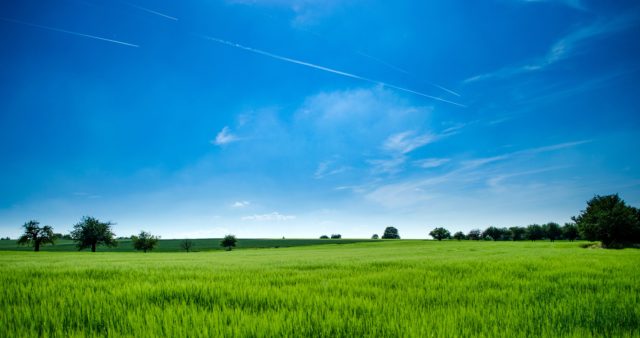
Nonpoint Source Pollution
NPS pollution occurs when runoff from rain or snow melt flows overland to enter rivers and lakes. The water picks up anything and everything found on the land or in the soil, which can include pollutants of many forms (e.g., excess nutrients from fertilizers, oil from cars, or salt from roads). These pollutants are then carried into water bodies, and their concentrations rise as each stream flows into the next. Ultimately, the pollutants end up at the mouth of a stream or lake. NPS pollutants come from a variety of sources all over the watershed and it’s impossible to “point” at where they are originating.
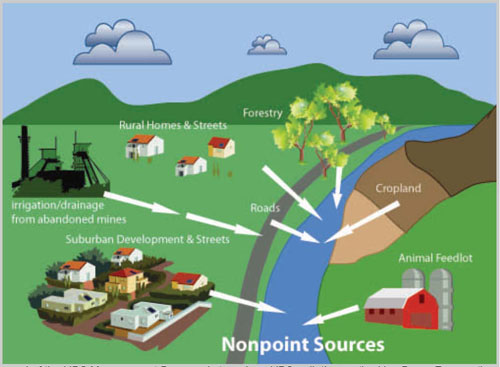
Unlike its counterpart, Point Source pollution, which is relatively easy to control and mitigate because it comes from one obvious source, NPS pollution is very difficult to control as it requires much more planning and volunteer efforts to make a difference.
Tips for Pollution Prevention:
- Avoid overuse of fertilizers, herbicides, and insecticides
- Maintain & regularly service septic systems
- Never dump anything other than water into storm drains or sewer grates
- Install rain gardens to collect roof or driveway runoff
- Maintain healthy riparian areas to filter pollutants
Additional Resources:
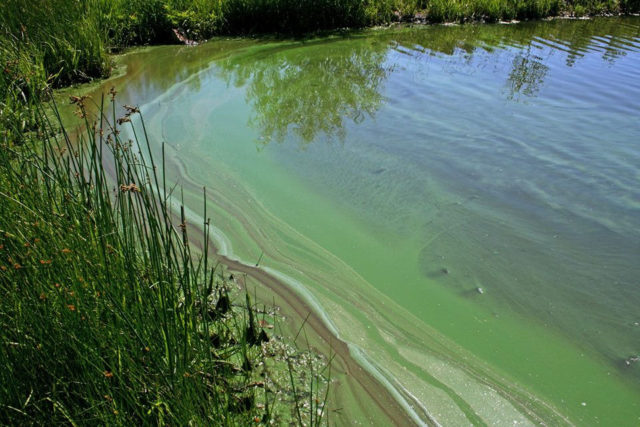
Aquatic Invasive Species (AIS)
AIS are any species, such as plants, animals, and pathogens, that are not native to an area and pose a substantial threat to the economy, culture, or ecosystem. AIS are introduced either intentionally, such as when aquariums or fish tanks are dumped into natural waters, or accidentally, such as when boats carrying invasive mussels are launched in local waterways. AIS pose a significant threat because our local waterways lack the natural predators of these invasive species. They quickly outcompete our native species and can cause irreversible changes to the species composition of natural ecosystems. Other impacts from AIS can include damage to irrigation equipment, loss of recreational opportunities, costly maintenance of hydraulic power infrastructure, degraded wildlife habitat, and public health risks.
Tips to Prevent AIS Spread:
- Stop at all boat check stations, every time
- Clean, Drain, & Dry any equipment that’s been in the water (including farming, gardening, and irrigation equipment) and have out of state equipment inspected before use in Montana
- Do not fill tanks in one location and empty them in another
- Plant only native species near any water source such as ponds, irrigation ditches, or streams
- Never release or dispose of anything, alive or dead, from an aquarium or fish tank into the environment
- Learn to identify AIS and report any suspected AIS locations
Additional Resources:
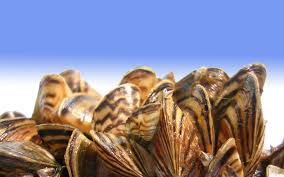
Riparian Areas
Riparian areas, also known as riparian zones and riparian buffers, are the interface between water and dry land. The deep-rooted vegetation characteristic of riparian areas provides several highly beneficial functions for landowners. First, the deep roots act as a net, holding the soil in place along the water’s edge and preventing erosion. Second, a riparian area acts as a sponge, soaking up excess water then slowly releasing it. In this way, they mitigate both floods and droughts. Third, they act as filters. Water runoff can carry harmful amounts of pollutants such as fertilizer and herbicide. As the runoff passes through a riparian area, the pollutants are captured and filtered before the runoff enters a waterbody. Finally, riparian areas shade water and help keep water temperatures low, preventing excess algae growth and maintaining habitat for fish and aquatic life.
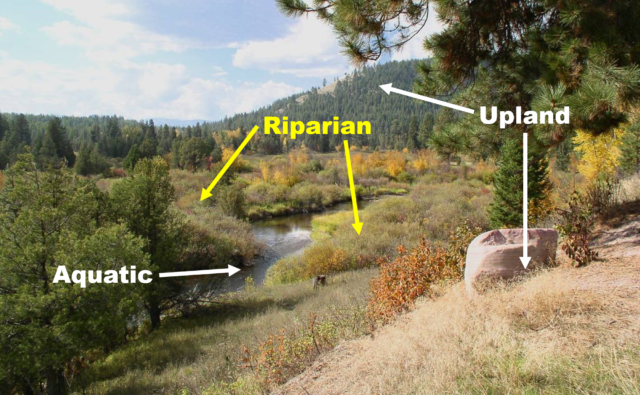
Tips for a Healthy Riparian Area:
- Always maintain deep-rooted vegetation along water’s edge
- Use a diversity of plant types, including trees, bushes, and grasses
- To maintain your view, plant tall, deep-rooting species along the sides of your view and shorter plants in the middle.
- Avoid mowing along the water’s edge to prevent loss of essential root mass which will lead to erosion
- Avoid building too close to the water’s edge and on the outer edge of river bends were erosion is more likely
- Build on upland areas and use permeable paths (made from wood, stone, or gravel) for access to the water
- Install septic systems outside riparian areas and keep them maintained
- Prevent livestock from damaging riparian areas by using fencing for short-term grazing or installing water gaps, hardened crossings, or offsite water.

